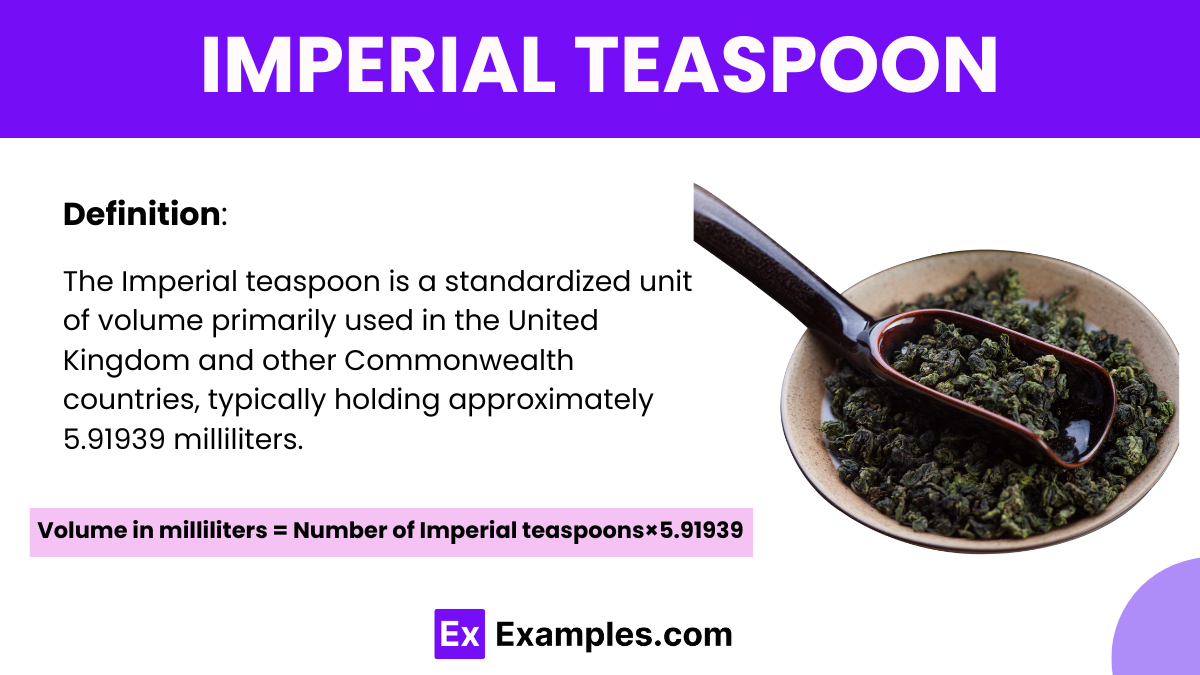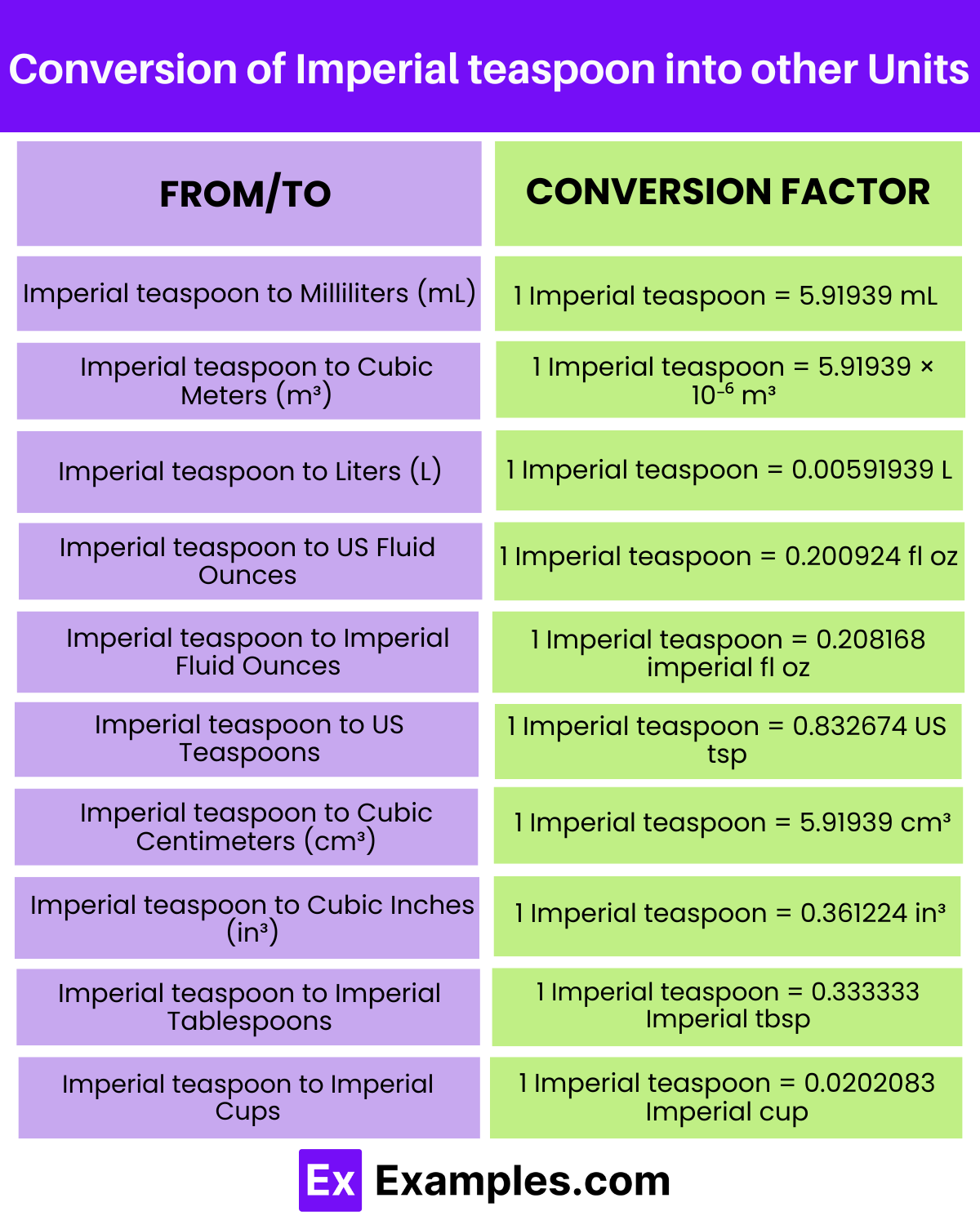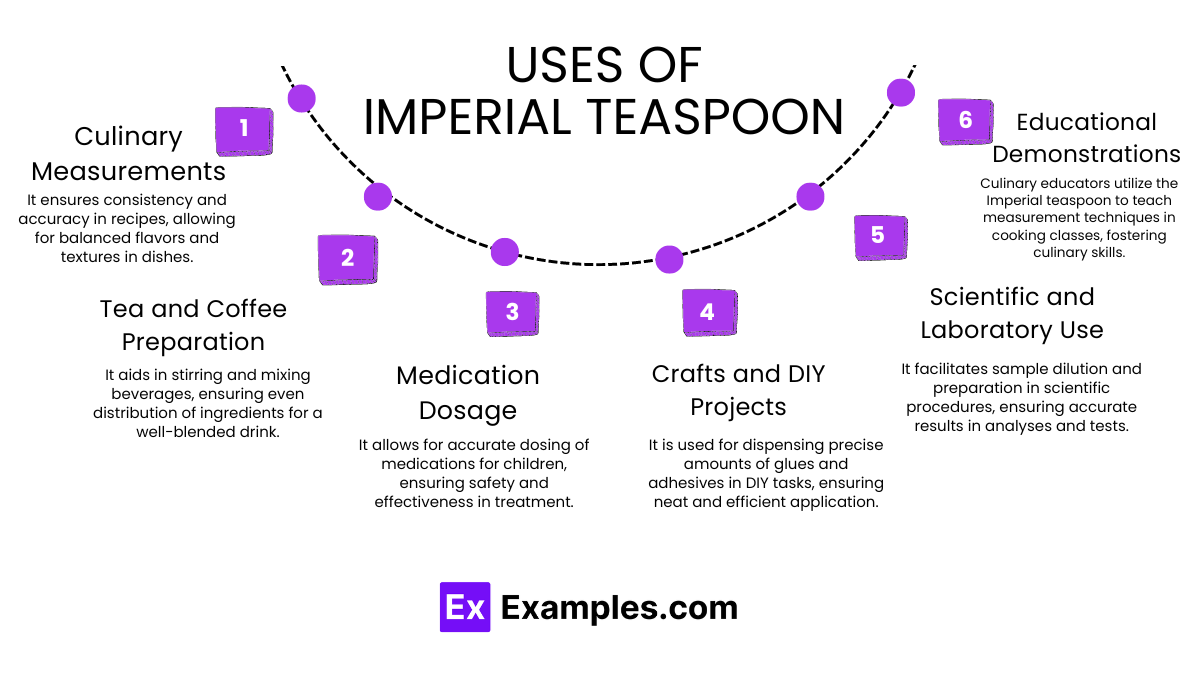How many milliliters are in an imperial teaspoon?
5 ml
4.9 ml
6.0 ml
3.7 ml


The Imperial teaspoon is a units of volume measurement used primarily in the United Kingdom and other Commonwealth countries. It is a standardized utensil for measuring small quantities of ingredients in cooking and baking. In the realm of physics and culinary arts, it serves as a fundamental tool alongside related units such as the US tablespoon, US fluid ounce, and US teaspoon, facilitating precise measurements for recipes and scientific experiments. Compared to its US counterparts, including the US liquid gallon, cubic meter, and liter, the Imperial tablespoon offers a distinct volume measurement, contributing to the culinary traditions and practices of its region.
Suppose you have 5 Imperial teaspoons of vanilla extract and you want to know the equivalent volume in milliliters.
Using the formula:
Volume in milliliters = Number of Imperial teaspoons×5.91939
Substituting the values:
Volume in milliliters = 5×5.91939
Volume in milliliters = 29.59695 milliliters
So, 5 Imperial teaspoons of vanilla extract is approximately equal to 29.6 milliliters.
The metric system provides a standardized approach to measuring volume, making it easier to communicate and compare quantities across different contexts. In the case of the Imperial teaspoon, its volume can be expressed in milliliters, which is a common unit in the metric system.
For example, let’s convert the volume of an Imperial teaspoon to milliliters using the conversion factor:
1 Imperial teaspoon ≈ 5.91939 milliliters
So, if we have 3 Imperial teaspoons of sugar, we can calculate the equivalent volume in milliliters:
Volume in milliliters=Number of Imperial teaspoons×Conversion factorVolume in milliliters=Number of Imperial teaspoons×Conversion factor Volume in milliliters=3×5.91939Volume in milliliters=3×5.91939 Volume in milliliters≈17.75817 millilitersVolume in milliliters≈17.75817milliliters
| Parameter | US Teaspoon | Imperial Teaspoon |
|---|---|---|
| Volume | Approximately 4.92892 milliliters | Approximately 5.91939 milliliters |
| Usage | Primarily used in the United States | Primarily used in the United Kingdom |
| Metric Equivalent | 1 US teaspoon ≈ 4.92892 mL | 1 Imperial teaspoon ≈ 5.91939 mL |
| Common Applications | Culinary measurements, medication dosages | Culinary measurements, tea and coffee preparation |
| Variants | Metric teaspoon (exact 5 mL) is commonly used | Metric teaspoon (ex |
| SI Multiple | Symbol | Multiplier | Volume in Milliliters (mL) |
|---|---|---|---|
| Milliliter | mL | 1 | 5.91939 |
| Centiliter | cL | 0.01 | 0.0591939 |
| Deciliter | dL | 0.1 | 0.591939 |
| Liter | L | 1 | 5.91939 |
| Hectoliter | hL | 100 | 591.939 |
| Kiloliter | kL | 1000 | 5919.39 |

| To Unit | Conversion Factor | Example |
|---|---|---|
| Imperial teaspoon to Milliliters (mL) | 1 Imperial teaspoon = 5.91939 mL | 10 Imperial teaspoons = 59.1939 mL |
| Imperial teaspoon to Cubic Meters (m³) | 1 Imperial teaspoon = 5.91939 × 10⁻⁶ m³ | 10 Imperial teaspoons = 5.91939 × 10⁻⁵ m³ |
| Imperial teaspoon to Liters (L) | 1 Imperial teaspoon = 0.00591939 L | 10 Imperial teaspoons = 0.0591939 L |
| Imperial teaspoon to US Fluid Ounces | 1 Imperial teaspoon = 0.200924 fl oz | 10 Imperial teaspoons = 2.00924 fl oz |
| Imperial teaspoon to Imperial Fluid Ounces | 1 Imperial teaspoon = 0.208168 imperial fl oz | 10 Imperial teaspoons = 2.08168 imperial fl oz |
| Imperial teaspoon to US Teaspoons | 1 Imperial teaspoon = 0.832674 US tsp | 10 Imperial teaspoons = 8.32674 US tsp |
| Imperial teaspoon to Cubic Centimeters (cm³) | 1 Imperial teaspoon = 5.91939 cm³ | 10 Imperial teaspoons = 59.1939 cm³ |
| Imperial teaspoon to Cubic Inches (in³) | 1 Imperial teaspoon = 0.361224 in³ | 10 Imperial teaspoons = 3.61224 in³ |
| Imperial teaspoon to Imperial Tablespoons | 1 Imperial teaspoon = 0.333333 Imperial tbsp | 10 Imperial teaspoons = 3.33333 Imperial tbsp |
| Imperial teaspoon to Imperial Cups | 1 Imperial teaspoon = 0.0202083 Imperial cup | 10 Imperial teaspoons = 0.202083 Imperial cup |
The Imperial teaspoon, a standard unit of volume, corresponds to approximately 5.91939 milliliters, making it a convenient measure for small quantities in culinary and scientific applications.
When expressed in cubic meters, an Imperial teaspoon equates to a minute volume, highlighting the disparity between everyday measurements and the scale of larger quantities used in scientific contexts.
Converting Imperial teaspoons to liters emphasizes their modest volume, underscoring their utility in precise ingredient measurements and recipe formulations in culinary practices.
An Imperial teaspoon roughly translates to 0.200924 US fluid ounces, showcasing its smaller capacity compared to the US teaspoon and its role in traditional British culinary traditions.
In Imperial fluid ounces, an Imperial teaspoon is equivalent to approximately 0.208168, highlighting the slight difference between US and Imperial fluid ounce measurements.
Converting Imperial teaspoons to US teaspoons illustrates the discrepancy between US and Imperial volume standards, impacting recipe accuracy and culinary outcomes.
Expressed in cubic centimeters, an Imperial teaspoon showcases its spatial volume, aiding in visualizing its capacity and its relevance in scientific experiments and calculations.
Converting to cubic inches underscores the Imperial teaspoon’s diminutive size in the context of larger volumes, offering perspective on its scale and usage in everyday tasks.
The conversion to Imperial tablespoons highlights the relationship between different British volume measures, facilitating seamless conversions and accurate ingredient usage in recipes.
Expressed in Imperial cups, an Imperial teaspoon represents a fraction of a cup, illustrating its role in precise ingredient measurement for cooking and baking applications
Imagine you’re preparing a traditional British tea recipe that requires precise measurements. You need to add sugar to the tea, and the recipe calls for 2 teaspoons of sugar per cup. Using your Imperial teaspoon, you measure out the sugar, ensuring each teaspoon is leveled for accuracy.
As you add the sugar to the tea, you notice how the small volume of the Imperial teaspoon allows you to control the sweetness of the tea, ensuring it’s just right. This demonstrates the practical application of the Imperial teaspoon in accurately measuring ingredients for culinary perfection, especially in recipes where precision is key, such as in traditional tea-making practices.

The Imperial teaspoon is slightly larger than the US teaspoon, with the former typically holding approximately 5.91939 milliliters compared to the latter’s 4.92892 milliliters.
The metric teaspoon is standardized to hold exactly 5 milliliters, whereas the Imperial teaspoon holds approximately 5.91939 milliliters.
While Imperial teaspoons provide a convenient measure for small quantities, their accuracy may vary slightly depending on factors such as the shape of the spoon and the technique used for leveling.
<p><br/></p>
Text prompt
Add Tone
10 Examples of Public speaking
20 Examples of Gas lighting
How many milliliters are in an imperial teaspoon?
5 ml
4.9 ml
6.0 ml
3.7 ml
What is the volume of an imperial teaspoon in cubic centimeters (cc)?
5 cc
4.9 cc
6 cc
3.7 cc
How does the volume of an imperial teaspoon compare to a US teaspoon?
It is larger
It is smaller
It is the same
It varies
In cooking measurements, how many imperial teaspoons are there in one imperial tablespoon?
1
2
3
5
What is the equivalent of 2 imperial teaspoons in milliliters?
9.8 ml
10 ml
7.4 ml
8 ml
If a recipe calls for 1 imperial teaspoon of an ingredient, how many US teaspoons would be required?
1 US teaspoon
1.02 US teaspoons
0.98 US teaspoons
2 US teaspoons
How many imperial teaspoons are in one imperial fluid ounce?
4
5
6
7
What is the volume in imperial teaspoons of 25 ml of liquid?
5.1 teaspoons
5.5 teaspoons
5.3 teaspoons
5.7 teaspoons
Convert 10 imperial teaspoons to imperial tablespoons.
3 tablespoons
3.33 tablespoons
3.5 tablespoons
2.5 tablespoons
How many imperial teaspoons are in half an imperial pint?
80
85
90
95
Before you leave, take our quick quiz to enhance your learning!

